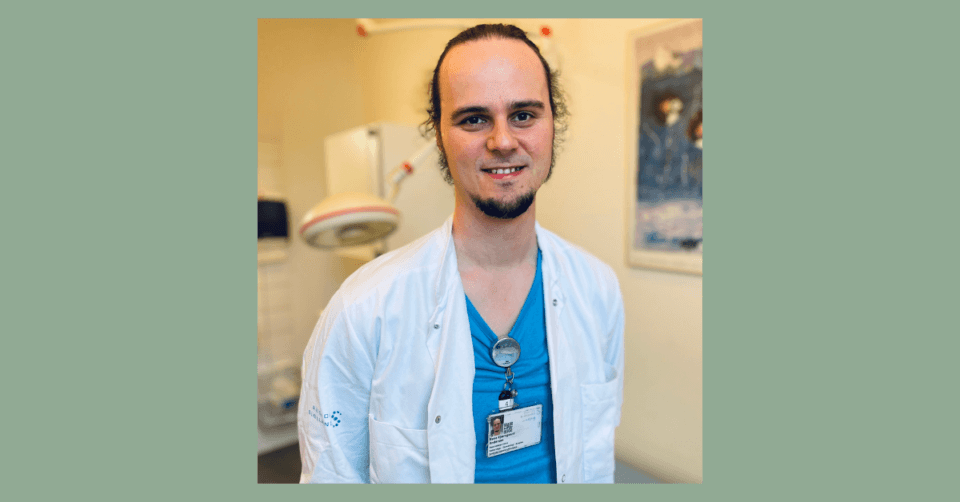4 November 2024
Rune Kjærsgaard Andersen, Medical Doctor and current Postdoc, is one of four talented skin researchers to receive a LEO Foundation Dr Abildgaard Fellowship of DKK 12 million. His pioneering research will carve a significant path in dermatology with a primary focus on hidradenitis suppurativa (HS), a debilitating chronic skin disease. Dr Andersen aims to transform clinical approaches to HS by introducing personalized medicine as a preventive tool, paving the way for more effective and tailored treatments.
“The potential to introduce preventive personalized medicine into the clinical practice is a game changer,” says Rune Kjærsgaard Andersen, Medical Doctor, Postdoc and one of four Dr Abildgaard Fellows of 2024.
With a grant of DKK 12 million, the fellowship from the LEO Foundation will support Rune Kjærsgaard Andersen’s development of predictive algorithms to identify HS patients at high-risk of experiencing disease progression and/or development of severe comorbidities.
“If we can identify patients at high risk of severe disease or associated comorbidities, such as diabetes, stroke or cancer, we can direct our healthcare resources where they are most needed. Furthermore, those who are not offered preventive intervention can rest assured that this is because they belong to the low-risk group,” Rune Kjærsgaard Andersen explains.
Rune Kjærsgaard Andersen’s fellowship is granted as a part of the LEO Foundation’s Dr Abildgaard 2024 research theme: Systems Medicine in Dermatology. He will relocate as a Group Leader and Research Manager to the Department of Dermatology and Allergy at Herlev and Gentofte Hospital.
Transforming HS care through predictive analytics
HS is a chronic inflammatory skin disease that causes the formation of painful, impairing and suppurating boils. It affects 1-4% of the global population, imposing significant costs to both individuals and society. While effective treatments exist, they are expensive and typically reserved for severe cases.
Building on Rune Kjærsgaard Andersen’s expertise in clinical research, complex data analysis of genetic and environmental risk factors, and the construction of temporal disease trajectories, his pioneering work holds the potential to shift the focus in HS from treatment to prevention.
In his research, he will leverage large clinical cohorts and use state-of-the-art techniques in data mining, clinical epidemiology, population genetics, and molecular biomedicine. These insights will contribute to developing predictive algorithms to help clinicians identify high-risk patients early, allowing for prompt, preventive intervention.
Combining clinical practice with research
Rune Kjærsgaard Andersen’s passion for research began early in his medical career. Even before completing his medical degree, he dove into clinical research as a pre-graduate research student, an experience that sparked his enduring interest in combining clinical practice with scientific inquiry. His path in dermatology led to a PhD focused on clinical epidemiology and population genetics, with the primary goal of addressing unanswered scientific questions that directly impact his patients.
During his postdoc at the University of Copenhagen, Rune Kjærsgaard Andersen expanded his expertise to include advanced data mining and techniques in molecular biomedicine, strengthening his ability to analyze complex patient data and identify those at higher risk of severe disease progression, comorbidities, or poor treatment responses.
A visionary leader and lifelong learner
Looking ahead to leading his own research group, Rune Kjærsgaard Andersen draws inspiration from the many great mentors he has had throughout his career.
“They have taught me that being available and easily accessible to all members of your team is paramount. When everyone is encouraged to contribute and allowed to pose new research questions, the group develops smoothly, ensuring that each member can mature and take on increasing responsibilities,” he explains.
Outside the lab, Rune Kjærsgaard Andersen enjoys spending time in his personal library, where he delves into a wide range of literature, from the fables of Tales of 1001 Nights to the intricate world-building of J.R.R. Tolkien and the societal critiques of Fyodor Dostoevsky.
